1995 Oldsmobile Cutlass Supreme towing
[x] Cancel search: towingPage 69 of 340
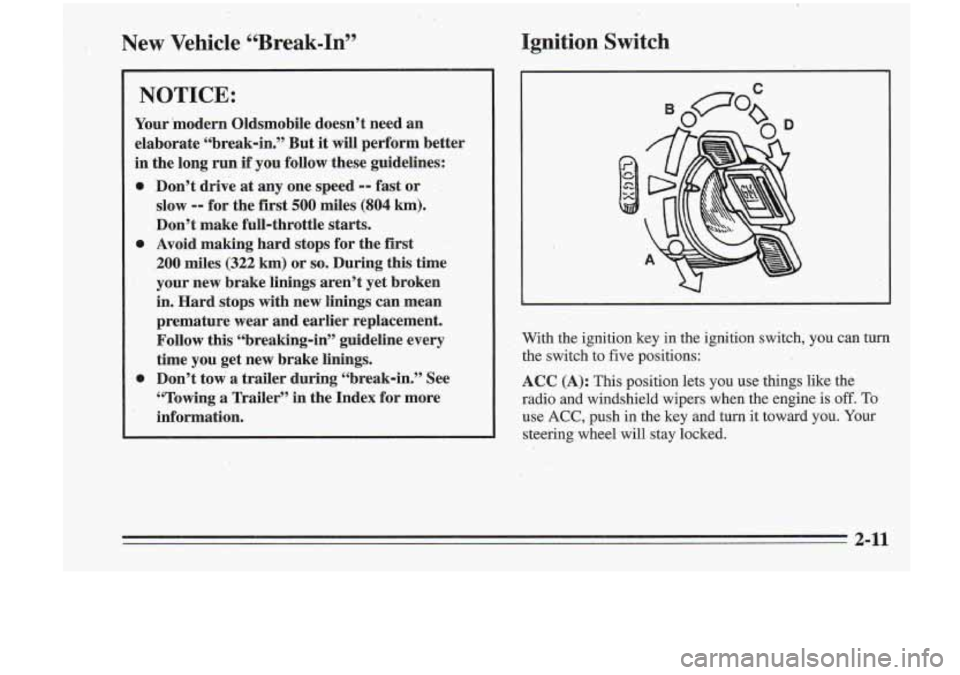
New Vehicle “Break-In” Ignition Switch
NOTICE:
Your *modern Oldsmobile doesn’t need an
elaborate “break-in.” But it
will perform better
in the long run
if you follow these guidelines:
0 Don’t drive at any one speed -- fast or
slow 0- for the first 500 miles (804 km).
Don’t make full-throttle starts.
0 Avoid making hard stops for the fist
200 miles (322 km) or so. During this time
’ your new brake linings aren’t yet broken
in. Hard stops with new linings can mean
premature wear and earlier replacement.
Follow this “breaking-in” guideline every
time you get new brake linings.
0 Don’t tow a trailer during “break-in.” See
“Towing
a Trailer” in the Index for more
information.
..
C
With the ignition key in the ignition switch, you can turn the switch to five positions:
ACC (A): This position lets you use things like the
radio and windshield wipers when the engine is off. To
use
ACC, push in the key and turn it toward you. Your
steering wheel will stay locked.
3-1 I
Page 71 of 340
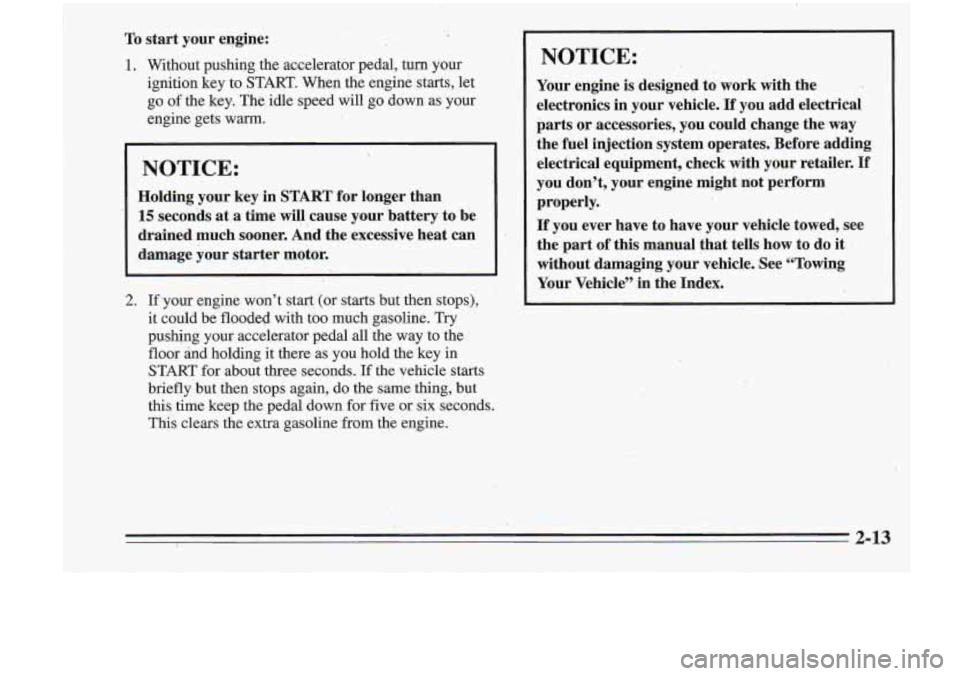
To start your engine:
1. Without pushing the accelerator pedal, turn your
ignition key to
START. When the engine starts, let
go of the key The idle speed will go down as your
engine gets warm.
NOTICE:
Holding your key in START for longer than -- 15 seconds at a time will cause your battery to be
drained much sooner. And the excessive heat can
.damage your starter motor.
2. If-your engine won’t staq (or starts but then stops),
it could be flooded with
too much gasoline. Try
pushing your accelerator pedal all the way to the
floor and holding it there as you hold the key in
START
for about three sec,onds. If the vehicle starts
briefly but then stops again, do the same thing, but
this time keep the pedal down
for five or six seconds.
This clears the extra gasoline from the engine.
I
NOTICE:
Your engine is designed to work with the .
electronics in your vehicle. If you add electrical
parts or accessories, you could,change the
way
the fuel injection system operates. Before adding
electrical equipment, check with your retailer.
If
you don’t, your engine might not perform
properly.
If you ever have to have your vehicle towed, see
the part of this manual that tells how to do
it
without damaging your vehicle. See “Towing
Your Vehicle” in the Index.
\. 2-13
.
Page 75 of 340
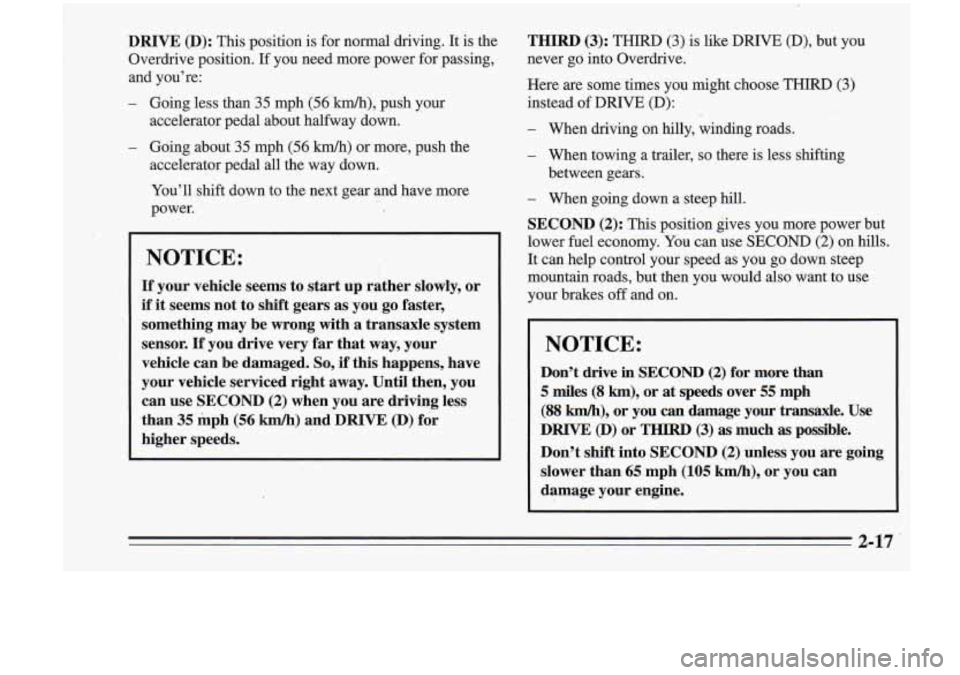
DRIVE (D): This position is for normal driving. It is the
Overdrive position. If you need more power for passing,
and you’re:
- Going less than 35 mph (56 M), push your
accelerator pedal about halfway down.
- Going about 35 mph (56 kmh) or more, push the
accelerator pedal all the way down.
You’ll shift down to the next gear and have more
power.
NOTICE:
If your vehicle seems tb start up rather slowly, or
if it seems not to
shift gears as you go faster,
something
may be wrong with a transaxle system
sensor.
If you drive very far that way, your
vehicle can be damaged.
So, if this happens, have
your vehicle serviced right away. Until then, you
can use SECOND
(2) when you are driving less
than
35 mph (56 km/h) and DRIVE (D) for
higher speeds. THIRD
(3): THIRD (3) is like DRIVE (D),
but you
never
go into Overdrive.
Here are some times you might choose THIRD
(3)
instead of DRIVE (D):
- When driving on hilly, winding roads.
- When towing a trailer, so there is less shifting
- When going down a steep hill.
SECOND
(2): This position gives you more power but
lower fuel economy. You can use SECOND
(2) on hills.
It can help control your speed
as you go down steep
mountain roads, but then you would also want to use
between gears.
lr
brakes off and on.
NOTICE:
Don’t drive in SECOND (2) for more than
5 miles (8 km), or at speeds over 55 mph
(88 km/h), or you can damage your transaxle. Use
DRIVE
@) or THIRD (3) as much aspossible.
Don’t
shift into SECOND (2) unless you are going
slower than
65 mph (105 km/h), or you can
damage your engine.
Page 77 of 340
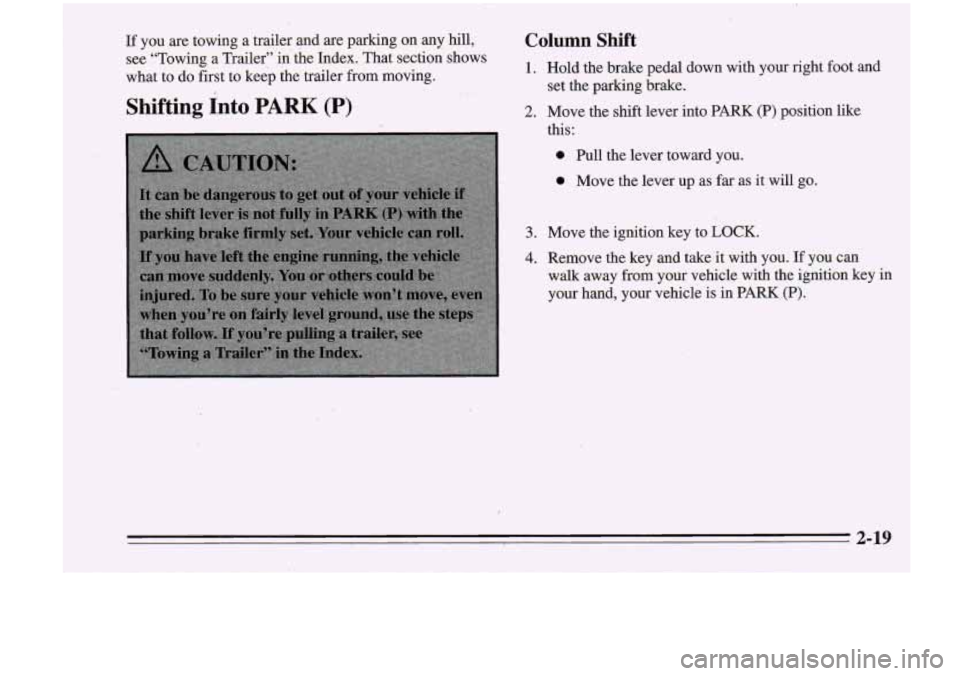
If you are towing a trailer and are parking on any hill, Column Shift
see “Towing a Trailer” in’ the Index. That section shows
what to do first to keep the trailer from moving. 1. Hold’the brake pedal down with your right foot and
set the parking brake.
Shifting Into PARK (P) 2. Move the shift lever into PARK (P) position like
2-19
c
Page 106 of 340
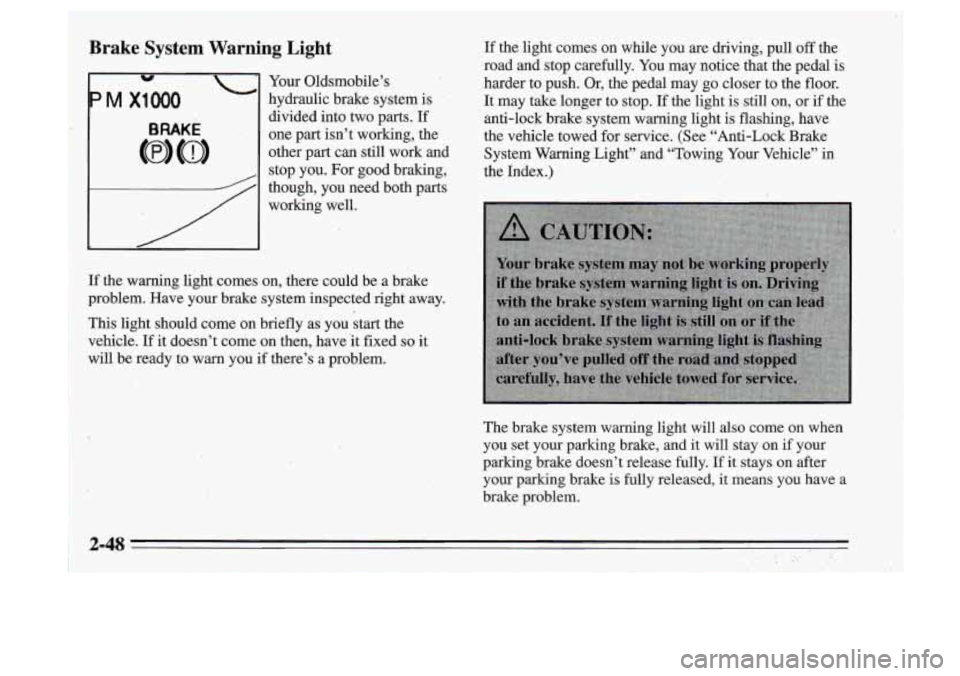
Brake System Warning Light
Your Oldsmobile’s
hydraulic brake system is
divided into two parts. If
one part isn’t working, the
other
part can still work and
stop you. For good braking,
though, you need both parts
working well. If
the light comes on while you
are driving, pull off the
road and stop carefully. You may notice that the pedal is
harder to push. Or,
the pedal may go closer to the floor.
It may take longer to stop.
If the light is still on, or if the
anti-lock brake system warning light
is flashing, have
the vehicle towed for service. (See “Anti-Lock Brake
System Warning Light” and “Towing Your Vehicle” in
the Index.)
If the warning light comes on, there could be a brake
problem. Have your brake system inspected right away.
:This light should come on briefly as you start the
vehicle. If it doesn’t come on then, have it fixed
so it
mill be ready to warn you
if there’s a problem.
The brake.system warning light will also come on when
you set your parking brake,
and it will stayion if your
parking brake doesn’t release fully. If it stays on after
your parking brake is fuily released, it means you have a
brakerproblem.
2-48
Page 166 of 340
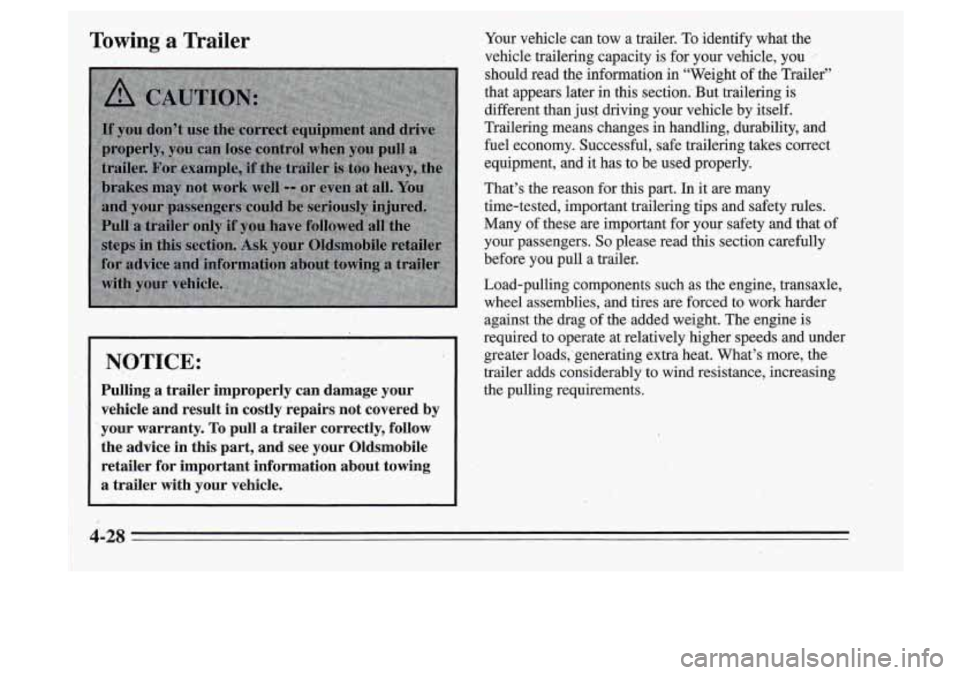
NOTICE:
Pulling a trailer improperly can damage your vehicle and resalt
in costly repairs not covered by
jour warranty.
To pull a trailer correctly, follow
the advice in this part, and see your Oldsmobile
retailer for important information about towing a trailer with your vehicle.
Page 167 of 340
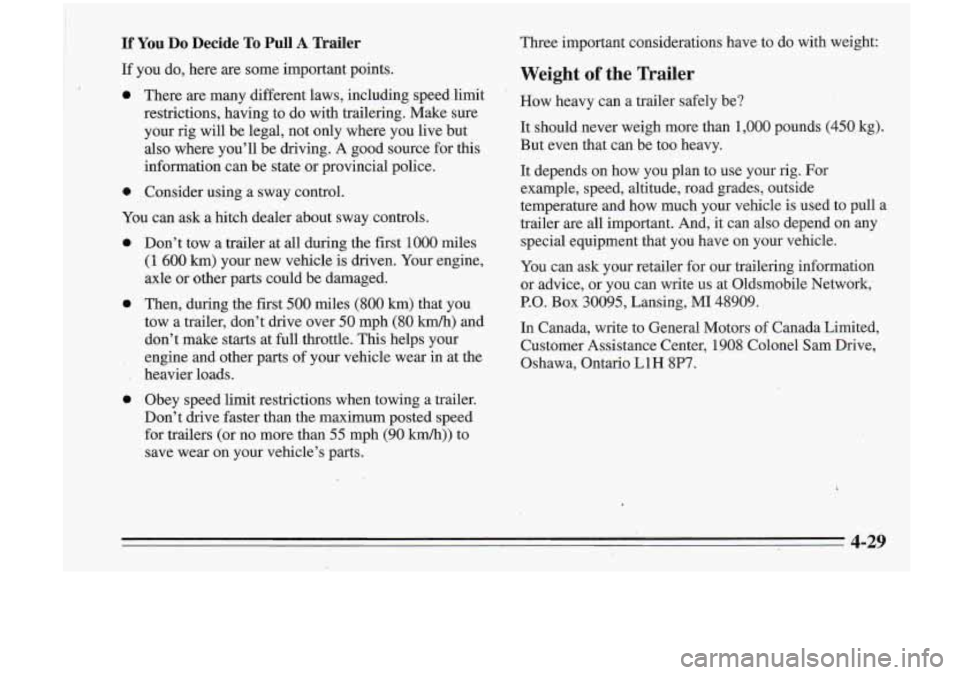
I
I
If You Do Decide To Pull A Trailer
If you do, here are some important points.
0 There are may different laws, including speec i limit
restrictions, having to do with trailering. Make sure
your rig will be legal, not only where you live but
also where you’ll be driving. A good source for this
information can be state or provincial police.
0 Consider using a sway control.
You can ask a hitch dealer about sway controls.
0
0
0
Don’t tow a trailer at all during the first 1000 miles
(1
600 km) your new vehicle is driven. Your engine,
axle or other parts could be damaged.
Then, during
the first 500 miles (800 km) that you
tow a trailer, don’t drive over
50 mph (80 km/h) and
don’t make starts at, full throttle. This helps your
engine and other parts of your vehicle wear in at the
heavier loads.
Obey speed limit restrictions when towing a trailer.
Don’t
drive faster than the’maximum posted speed
for trailers (or no more than 55 mph (90 km/h)) to
save wear on your vehicle’s parts. Three important
considerations have to do with weight:
Weight of the Trailer
How heavy can a trailer safely be?
It should never weigh more than 1,000 pounds
(450: kg).
But even that can be too heavy.
It depends on how you plan to use your rig.
For
example, speed, altitude, road grades, outside
temperature and how much your vehicle is, used to pull
a
trailer are all important. And, it can also depend on any
special equipment that you have on your vehicle.
You can ask your retailer for our trailering information
or advice, or
you can write us at Oldsmobile Network,.
P.O. Box 30095, Lansing, MI 48909.
In Canada, write to General Motors of Canada Limited,
Customer Assistance Center, 1908 Colonel
Sam Drive,
Oshawa, Ontario LlH
8P7.
4-29
I
Page 170 of 340
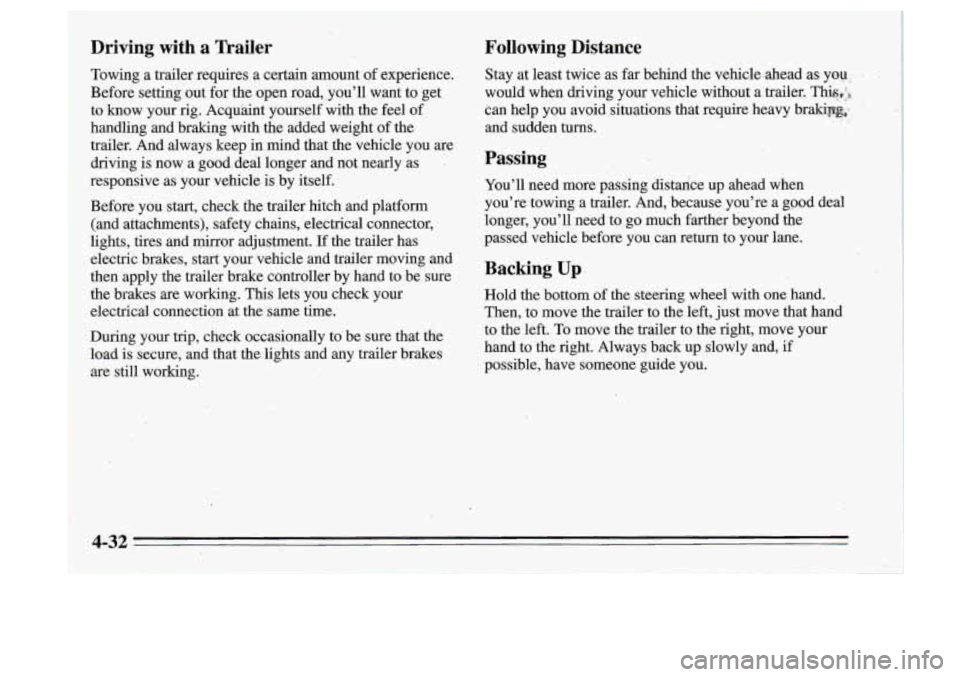
-
I
,'
Driving with a Trailer Following Distance
Towing a trailer requires a certain amount
of experience. Stay at least twice as far behind the vehicle .ahead as- you - .
Before setting out for the open road, you'll want to get would when driving your veh\
icle without a trailer. This$,
to know your rig. AcquQint yourself with the feel of can help you avoid situations that require heavy br-it
and sudden turns.
handling and braking with the added weight of the
trailer. And always keep in mind that ,the vehicle you are
driving is now a good deal longer
and not nearly as . Passing
responsive as your vehicle is by itself. You'll need more passing distance up ahead when
Before you start, check the.trailer hitch and platform you're' towing a trailer. And, because you're a good deal
(and attachments), safety chains, electrical connector, longer, \
you'll need to go much farther beyond the
lights, tires and mirror adjustment.
If the trailer has passed vehicle before you can return to your \
lane.
electric brakes, start your vehicle and trailer moving and
the brakes are working. This lets you check ,your Hold the bottom
of the steering wheel with one hand.
electrical connection at the same time. Then, to move the trailer
to the left, just move that hand
During your
trip, check occasionally to' be sure that the to the left.
To move the trailer to the right, move your
load is secure, and that the lights and any trailer brakes hand to the right. Always back up slowly and, if
are still working. possible. have someone guide you.
.. . ~.
then apply the trailer brake controller by hand to be sure Backing Up
?'